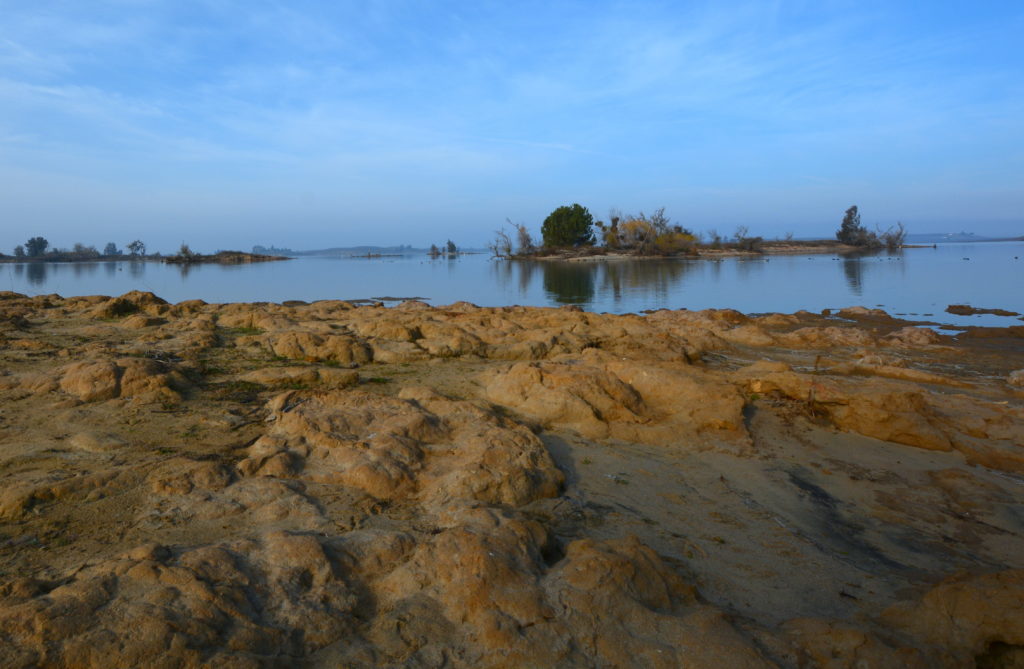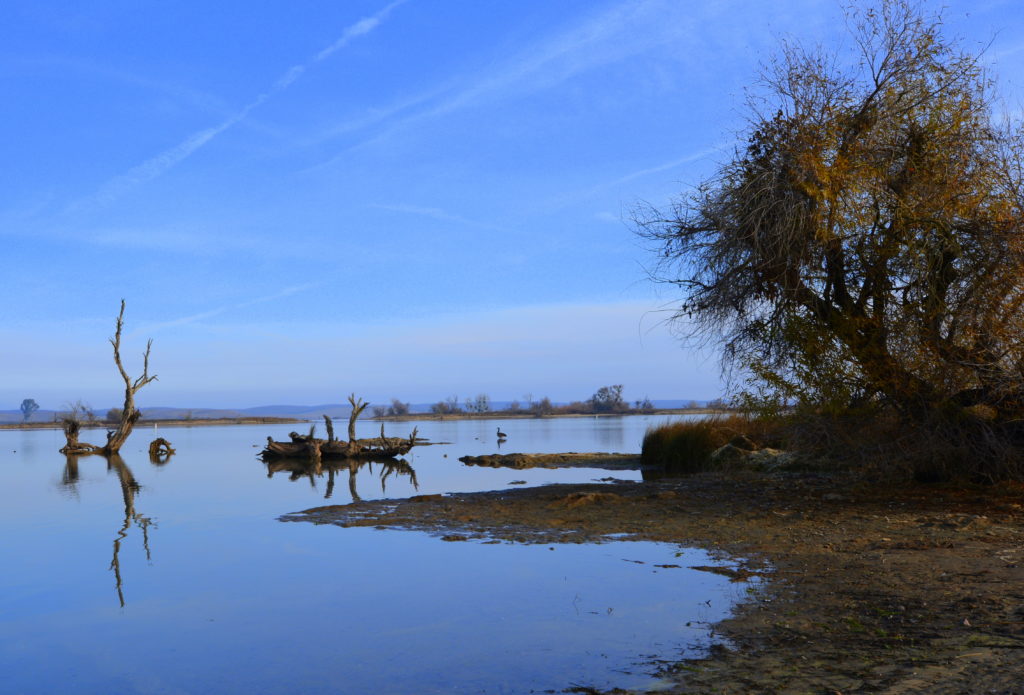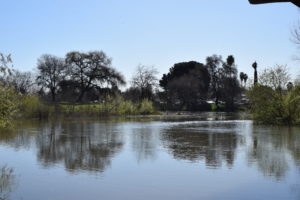
With record rain and snowfall in the winter of 2018-2019, many people are no longer worried about the water supply. The drought is over for now and reserves are growing in lakes and reservoirs. Nevertheless, recent concerns about water are no less relevant today than they were before our winter rains.
Ron Myers monitors wells for farms throughout the San Joaquin Valley. Although we have plenty of water this year, when the dry years return, Mr. Myers says we may experiences shortages faster than we did during the last drought.
During wet years, the availability of surface water relieves pressure on groundwater. With less pumping, the drop in demand reduces the drawdown from underground aquifers. Unfortunately, the rate of recharge of underground water is slower than the increased demand during dry years.
Mr. Myers said that during the five year drought that ended a couple of years ago, the drop in the water table throughout much of the Great Valley was substantial.
In the first year of the drought, Myers noted that the water table throughout the Valley fell an average of about a foot, with the rate of decline varying by location.
In the fourth year of the drought, the drop was as much as five feet in many locations.

In the fifth year, the water table dropped by as much as 20 feet, which is very alarming for agricultural interests. Farming cannot be sustained when the water table falls below 450 feet because the cost to pump the water makes farming unprofitable.
In the Lost Hills area of the Southern San Joaquin Valley and in a number of other Valley locations, no groundwater remains to be pumped. If farming is to happen in those areas, either surface water has to be available or the land will go fallow.
Mr. Myers noted that some farmers are switching from row crops to orchards in order to reduce water use. Others are switching to crops needing less water to survive. Land abandonment occurs where no water can be secured. T
The Madera County Experience
The eastern side of Madera County is an area of critical concern as large numbers of ranches and ranchettes rely solely on ground water supplies. Lacking an irrigation district, many owners have had to sink deeper wells or do without water. The water table in some wells is close to the 450 foot level of unsustainability.

A well can be drilled as deep as 1500 feet or even deeper, but few can afford the expense.
During the drought, Dennis Smith moved away from his ranchette after rebuilding his well to a depth of 360 feet in an unincorporated urban area near Avenue 12, about 10 miles southeast of the city of Madera. Mr. Smith said that he did not want to be present if or when the area runs out of water. He said that the water table had dropped 10 feet in one year and expected that his well would need to be drilled down further within a few years.
Greater Effort Needed to Find and Implement Solutions
Because different areas of the Valley have different shortage issues, an assortment of possible solutions is possible.
Ron Myers said that Stanislaus County is in relatively good shape compared to the rest of the Great Valley. The area is served by two major rivers, providing an abundance of surface water, aided by a robust canal system. However, the situation could quickly turn ugly if efforts to grab water rights are successful or if local irrigation districts continue to export water.

The California State Water Board and State Legislature have been very unimaginative where it comes to finding and implementing solutions. Building big expensive dams, building a big expensive tunnel, and stealing water from one part of the state to benefit another seem to be the main ideas being talked about.
Building desalinization plants near Santa Maria and pipelines to send water to the Southern San Joaquin Valley are not being discussed. We aren’t hearing much about recycling water. Nor is anyone talking about building numerous small coffer dams and ponds in the Great Valley to reduce runoff and river flooding; such devices could facilitate groundwater recharge.
The only thing certain about the Central Valley’s water supply is that it will continue to shrink until someone figures out what to do about the problem.

Once again, The Valley Citizen fails to highlight the biggest waste of water by far–the inane releases of so-called “pulse flows” down the San Joaquin River system–including the Stanislaus, Merced, and Tuolumne Rivers–for the purported purpose of rebuilding fish habitat. This practice, which California has engaged in since 2009, has flushed more than a trillion gallons of precious fresh, cold water into the rising oceans.
When this blog accurately provides a balanced perspective on water usage and conservation, it will gain a great deal more credibility. For now, it simply spouts the environmentalists’ party line.
Mr. Barton: Ultimately, the declaration that a water policy that provides clear benefits for one faction at the expense of another becomes nothing more than a cat fight. Fishermen and Delta farmers benefit from the “precious fresh, cold water” you want for your own ends, and so does the ecology of the San Francisco Bay. What you call “the environmentalists’ party line” another person calls wise use. As I recall, you are a proponent of sending northern California water south to corporate farmers. It’s okay to want that, but justifying that usage over other uses almost invariably involves some kind of “me first” ethic. Water belongs to the people…all the people. It is a telling point that here in the San Joaquin Valley a significant number of people lack safe drinking water altogether; I’m waiting for the day when “a balanced perspective” includes their needs and offers a remedy for their problems. What’s clear is there is not enough water; finding justification for its use by corporate AG is getting to be a harder and harder sell, but you are welcome to keep trying.
No, Mr. Caine, you’re incorrect. I have never advocated selling or moving water south. And your blog continues to advocate the enviros’ party line, and has never spoken out against–or even questioned–the inane dumping of water from our reservoirs into the ocean, even though that policy has failed to increase fish populations on the San Joaquin watershed. Further, the reality that non-native species in the Delta are eating the salmon fry to the detriment of the fishermen you choose to support is also never mentioned in your blog. Balance is just that–and your blog makes no attempt to offer that when you willingly emasculate agricultural interests when it comes to water policy. Some of us have operated in this region and made our living from farming for more than 100 years, but that seems to make no difference to you. As far as you’re concerned, we’re all lumped together. By the way, how do you define “corporate farmer”? Our family’s farming operation is incorporated, and it’s owned and operated by the 4th and 5th generations of our family members. I suppose we are “corporate farmers” by your definition?
Thank you Mr. Barton. I apologize for misrepresenting your views. I define “corporate Ag” as entities like the Boswells and Resnicks, not smaller businesses. However, I still maintain you have no more a claim on water than a Delta farmer or fisherman or environmentalist. That is my essential point. The “flushing water out to sea” meme ignores the rights of others, not to mention fundamentals of ecology.
The State Water Board’s plan is an exercise in stupidity. They use outdated science and never studied the rivers. Their flow only proposal is destined to fail just like everything else they’ve done. Thank goodness Felicia Marcus is gone. A pawn for radical Bay Area environmentalists like the NRDC
I will only reply that, having grown up on the Stanislaus River, I well remember–when the salmon population was abundant–literally being able to walk across the river during the late parts of August and early September before the autumn rains began. Somehow, the salmon population not only survived, but thrived–without the ill-advised releases from the reservoirs. Those releases, as you know, are currently made in both the spring and fall months–and have been for ten years now. Do I, as a farmer, have more of a claim on water than anyone else? No. But as it stands right now, the farmer is certainly at the bottom of the totem pole in terms of priorities from the perspective of the State Water Control Board.
Local farmers are still getting their water at below the cost of delivery and farmers down south continue to benefit from the socialized delivery systems provided by state and federal water projects. Stuart Resnick uses two-thirds the amount of water every year as the entire city of Los
Angeles. Forbes estimates his worth at just under $5 billion. If that’s the bottom of the totem pole, please make room, I’m coming down. The refusal to pay even the cost of delivery while whining about equitable distribution of water is indefensible when farmers have reaped so much benefit from the almond boom.
I find this article amusing – or at least the part where Mr Frohman proposes desal near Santa Maria with pipelines to the Central Valley as a replacement for local Central Valley groundwater. If pumping below 450′ in too expensive for farms then I can’t wait to see farmer’s expressions when their desalinated water is $2,000 AF. (although he probable imagines that CA taxpayers will subsidize this water and also pay for the sinking Friant-Kern Canal) Too many acres are in production due to socialized costs and privatized profits.
The myopia in the commentary is chilling.
Improved technology and economies of scale are gradually bringing down the cost of desalinization. If the higher cost of desalinized water is rolled into the rate structure of the entire state, water bills would rise at a modest rate.
Having no water is more catastrophic than a higher water bill.
Mr. Barton says the river used to have plenty of fish. What changed? We have been systematically killing off the ecosystem. The water releases were intended to help undo the damage. If nothing is done, the net result will be collateral damage to other species that depend on Salmon to survive. Is a massive die off of wildlife a desired outcome?
I have always been sympathetic to farming interests. The intent of the article was to highlight the need to do more than fight over water use. Unless more water is manufactured, urban users will eventually put farmers out of business because they can afford to pay more for water.
Shortage can quickly push up the price of water, while manufacture of water can prevent shortage. Isn’t an orderly market for water more desirable?